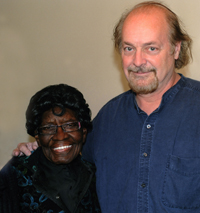

Curator’s Statement |
|||||||
“As I taught at Booker T. Washington, we tried to find within children what they did not see in themselves. We helped them to see what they could do. We knew children’s needs and helped them to see this for themselves. And we had the support of the parents. Everyone helped, everyone in the community—we were part of a large family.” Fannie Phelps Adams, a teacher during the Secondary School Study In many respects, I too felt as one of Fannie Phelps Adams children, and I have so cherished my time with her during these past years. Unlike the other school sites of the Secondary School Study, I took advantage of living in the same town with those students and faculty from Booker. I was able to develop a close friendship with Fannie Phelps Adams and spent much time with her both at her home as well as at the Museum where we would dedicate a bench in her name in our patio area. I never felt as if I was interviewing her, and she, similarly, mentioned on many occasions that our time together was not an occasion when I was conducting research. We were two educators, committed to our students and to the community and, crossing race, gender, and age barriers, we talked and talked. I learned much from my many sessions with her and allowed our discussions to go in any direction as I continued to attempt to understand the context of these progressive black schools.
While my ongoing conversations with Fannie Phelps Adams, Stonewall Richburg, and Judge Perry, all of whom participated in Museum of Education programs, proved so helpful and fruitful, I must admit that I was somewhat disappointed that I was unable to interview any Booker students from the Study. Actually, I find it quite ironic and, ultimately, understandable that the school with the lowest level of participation in the oral history portion of this project proved to be from my own hometown. Even with the Museum of Education's donation of important artifacts to Booker T. Washington Alumni Association’s Montieth School and my continued participation as an official photographer for the Association’s annual banquet—where I was taking photographs of 1940s students for the Association’s website—BTW students from the 1940s decided not to participate in the interview sessions. Craig Kridel |
|||||||
|
|||||||

an institutional member of the International Coalition of Sites of Conscience
Museumofed@gmail.com


